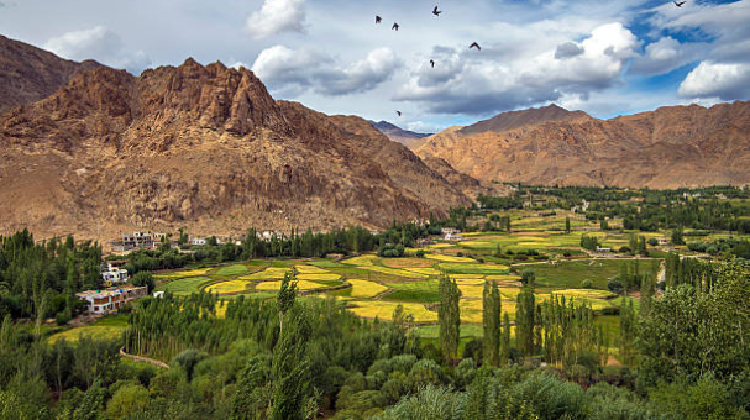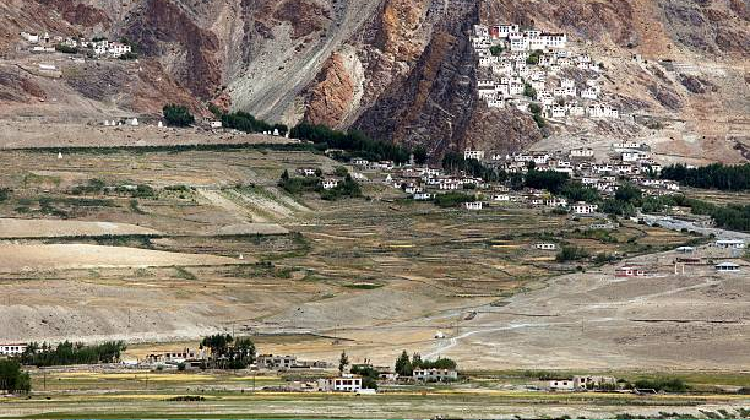Phyang Gompa, Ladakh
Dive into the majestic landscape of Ladakh lies the serene Phyang Monastery also known as Phyang Gompa. This ancient monastery with its whitewashed walls and golden stupas stands as a testament to the rich cultural and spiritual heritage of the region. In this comprehensive guide we delve into the history, architecture, spiritual significance, and travel tips related to Phyang Monastery of Ladakh inviting you to embark on a journey of exploration and enlightenment.



Traveller Information
- Famous For God Lovers, Nature Lovers
- Fee No Entry Fee
- Visiting Time 8am-1pm & 1.30-6pm
- Duration of Visit 3 to 4 hours
Ancient Origins of Phyang Monastery
Phyang Gompa traces its origins back to the 16th century when it was founded by Chosje Damma Kunga, a renowned Buddhist scholar and saint. The monastery belongs to the Drikung Kagyu school of Tibetan Buddhism and is renowned for its ancient scriptures, sacred relics, and vibrant festivals.
Over the centuries, Phyang Gompa has been a center for religious and cultural activities, attracting monks and scholars from Tibet, India, and beyond. Despite facing numerous challenges, including invasions and natural disasters, the monastery has thrived, preserving ancient teachings and practices.
Architectural Marvels of Phyang Monastery
The architecture of Phyang Gompa is a blend of Tibetan and Ladakhi styles characterized by whitewashed walls, colorful murals and intricately carved wooden balconies. The main temple known as the Dukhang houses a collection of ancient scriptures, thangkas (religious paintings), and statues of Buddhist deities. One of the unique features of Phyang Monastery is its assembly hall where monks gather for prayers, rituals, and philosophical debates. The hall is adorned with exquisite frescoes depicting scenes from the life of the Buddha and other religious motifs.
Spiritual Significance of Phyang Monastery
Phyang Monastery holds immense spiritual significance for followers of Tibetan Buddhism. It is believed to be a place of retreat and meditation, where monks engage in intensive practice to attain enlightenment.
One of the most revered relics at Phyang is a statue of Vajradhara, the primordial Buddha, believed to confer blessings and protection to devotees. The monastery also hosts several religious ceremonies and festivals throughout the year, providing devotees with an opportunity to deepen their spiritual practice and connect with the divine.
Best Time to Visit
The best time to visit Phyang Monastery Ladakh is during the summer months, from May to September, when the weather is pleasant and the roads are accessible. Winter months can be harsh, with heavy snowfall blocking mountain passes and restricting travel.
How to Reach Phyang Gompa
Phyang is located approximately 15 kilometers west of Leh, the capital of Ladakh. The journey from Leh to Phyang takes about 30 minutes by road.
- By Road: The most convenient way to reach Phyang is by road. Regular buses and taxis operate between Leh and Phyang, offering scenic views of the surrounding landscape.
- By Air: The nearest airport is Kushok Bakula Rimpochee Airport in Leh, which is well-connected to major cities like Delhi, Mumbai, and Srinagar. From Leh, you can hire a taxi or take a bus to Phyang.
- By Train: The nearest railway station is Jammu Tawi, located approximately 700 kilometers from Leh. From Jammu, you can take a bus or taxi to Leh and then proceed to Phyang by road.
Accommodation Options
While Phyang Gompa itself does not offer accommodation, there are several guesthouses and homestays in the nearby village of Phyang. These establishments provide basic amenities and a chance to experience the local Ladakhi hospitality. For more upscale options, travelers can find hotels and guesthouses in Leh, which offer a range of amenities and services.
Travel Tips
- Altitude Sickness: Phyang is situated at an altitude of about 3,600 meters (11,811 feet) above sea level. It’s essential to acclimatize properly to avoid altitude sickness. Spend a few days in Leh before heading to Phyang.
- Clothing: The weather in Ladakh can be unpredictable, so it’s advisable to carry layered clothing. Even in summer, temperatures can drop significantly at night.
- Permits: Indian nationals do not require special permits to visit Phyang. However, foreign nationals need to obtain an Inner Line Permit (ILP) to travel to certain restricted areas in Ladakh.
- Respect Local Customs: When visiting the monastery, dress modestly and be respectful of the monks and their practices. Photography inside the monastery may be restricted, so always ask for permission before taking pictures.
Nearby Attractions
- Likir Monastery: Visit Likir Monastery, another ancient Buddhist site known for its rich history and stunning architecture.
- Alchi Monastery: Explore Alchi Monastery, famous for its ancient murals and sculptures dating back to the 11th century.
- Magnetic Hill: Experience the mysterious phenomenon of Magnetic Hill, where vehicles appear to defy gravity and roll uphill.
Local Cuisine
Indulge in the flavors of Ladakhi cuisine by sampling traditional dishes such as thukpa, momos, and butter tea. Local eateries in Phyang and nearby villages offer authentic Ladakhi meals prepared with locally sourced ingredients.
In Conclusion
Phyang Monastery of Ladakh stands as a gateway to spiritual tranquility and cultural immersion in the heart of the Himalayas. Whether you seek spiritual
